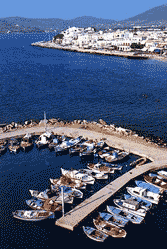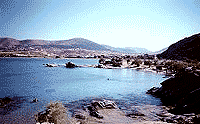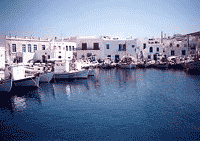 Island, one of the Cyclades in the Aegean Sea, Greece, separated from Naxos on the east by a channel 6 km wide. With an area of 194.5 sq km, it is formed by a single peak, Profitis Ilias (classical Marpessa), 771 m in height, which slopes evenly on all sides to a maritime plain that is broadest on the northeast and southwest sides. The island is mainly composed of marble. On a bay on the northwest lies the capital, Paros (or Paroikia,), occupying the site of the ancient and medieval capital. The small harbour is excelled by that of Naousa on the north side. White, semitransparent Parian marble (Paria Marmara), used for sculpture and quarried from subterranean pits on the north side of Mt. Marpessa, was the chief source of wealth for ancient Paros. Several of the marble tunnels have survived. Paros shared the early Bronze Age culture of the Cyclades. Traditionally it was first colonized by Arcadians and then by Ionians. In the 7th century BC Parian colonies were sent to Thasos and to Parium on the Sea of Marmara and in 385 to the island of Pharos (Hvar, Croatia) in the Adriatic. In 490 Páros joined the Persians and sent a ship to Marathon; in retaliation, its capital was attacked by an Athenian fleet under Miltiades. Paros also sided with Persia's king, Xerxes I, but after the Battle of Artemisium (480) its contingent remained in Kíthnos. After 480 a member of the Delian League, it joined the Second Athenian League in 378. On its political decline it passed to the Ptolemies of Egypt and thence to Roman rule. Following the brief Latin conquest of Constantinople (AD 1204), Paros was subject to Venice, becoming in 1389 an independent duchy. In 1537 it was taken by the Turks and was annexed to Greece in 1830 after the War of Greek Independence. It is an important archaeological site. The Parian Chronicle, found in about 1627, is a marble inscription giving an account of artistic milestones in early and classical Greece. North of the capital is a sanctuary of Delian Apollo and Artemis. The present economy depends largely on locally grown cereals, grapes, figs, olives, and tobacco. Separated from Paros on the southwest by a channel 1.4 mile (2.2 km) wide is the once-attached island of Antiparos, the ancient Oliarus, whose limestone cavern is a tourist attraction.
Island, one of the Cyclades in the Aegean Sea, Greece, separated from Naxos on the east by a channel 6 km wide. With an area of 194.5 sq km, it is formed by a single peak, Profitis Ilias (classical Marpessa), 771 m in height, which slopes evenly on all sides to a maritime plain that is broadest on the northeast and southwest sides. The island is mainly composed of marble. On a bay on the northwest lies the capital, Paros (or Paroikia,), occupying the site of the ancient and medieval capital. The small harbour is excelled by that of Naousa on the north side. White, semitransparent Parian marble (Paria Marmara), used for sculpture and quarried from subterranean pits on the north side of Mt. Marpessa, was the chief source of wealth for ancient Paros. Several of the marble tunnels have survived. Paros shared the early Bronze Age culture of the Cyclades. Traditionally it was first colonized by Arcadians and then by Ionians. In the 7th century BC Parian colonies were sent to Thasos and to Parium on the Sea of Marmara and in 385 to the island of Pharos (Hvar, Croatia) in the Adriatic. In 490 Páros joined the Persians and sent a ship to Marathon; in retaliation, its capital was attacked by an Athenian fleet under Miltiades. Paros also sided with Persia's king, Xerxes I, but after the Battle of Artemisium (480) its contingent remained in Kíthnos. After 480 a member of the Delian League, it joined the Second Athenian League in 378. On its political decline it passed to the Ptolemies of Egypt and thence to Roman rule. Following the brief Latin conquest of Constantinople (AD 1204), Paros was subject to Venice, becoming in 1389 an independent duchy. In 1537 it was taken by the Turks and was annexed to Greece in 1830 after the War of Greek Independence. It is an important archaeological site. The Parian Chronicle, found in about 1627, is a marble inscription giving an account of artistic milestones in early and classical Greece. North of the capital is a sanctuary of Delian Apollo and Artemis. The present economy depends largely on locally grown cereals, grapes, figs, olives, and tobacco. Separated from Paros on the southwest by a channel 1.4 mile (2.2 km) wide is the once-attached island of Antiparos, the ancient Oliarus, whose limestone cavern is a tourist attraction. The Archaeological Museum of Paros is situated in Parikia. In its properly arranged halls, there are remarkable archaeological finds on display from excavations conducted on the island as well as on Saliagos Isle which reveal the long history of the place. Among those that stand out are the headless statue of Demetra, a grave carved pile from the 7th century BC which represents a seated woman, a Roman mosaic representing Hercules hunting, a relief with the lyric poet Archilochos (6th BC century), a statue of Niki (Victory) of Paros (5th c.BC) as well as Hellenistic sculptured sarcophagi (2nd c. BC). But the most important exhibit in the museum is a chronological map of ancient Greek history covering 1318 years.
The Archaeological Museum of Paros is situated in Parikia. In its properly arranged halls, there are remarkable archaeological finds on display from excavations conducted on the island as well as on Saliagos Isle which reveal the long history of the place. Among those that stand out are the headless statue of Demetra, a grave carved pile from the 7th century BC which represents a seated woman, a Roman mosaic representing Hercules hunting, a relief with the lyric poet Archilochos (6th BC century), a statue of Niki (Victory) of Paros (5th c.BC) as well as Hellenistic sculptured sarcophagi (2nd c. BC). But the most important exhibit in the museum is a chronological map of ancient Greek history covering 1318 years.The Castle of Parikia includes a whole neighborhood of picturesque houses built around the ruins of the walls and the tower of a Venetian castle, built in 1260, on the location of the ancient acropole. Even today, one can still see specks of ancient temples, such as the temple of Demeter, which once stood here. Near the Castle, one can visit a series of churches, such as the Byzantine church of Agios Constantinos (1689) after which the area was named, the church of Agia Anna, Agia Ekaterini, Panagia Stavrou, Agios Onoufrios, as well as parts of the church of Christ (built in the 13th century). The church of Panagia Katopiliani, or Ekatondapyliani, is situated in Parikia. It took this name because it was situated "under the city", or, according to another version, because it had one hundred gates (ekato pyles) out of which only ninety-nine had been found and if the hundredth was found as well, then Greece would ...conquer Constantinople! Tradition says that it has been found in 326, or later (280-337), by St Helene, who made a votive offering to the Virgin Mary that she would build a large church on this site, if only she found the Holy Cross. According to another legend, it was built by Ignatios, the scholar of the chief workman of Agia Sofia's church, Isidoros. But the grandeur of his creation provoked the envy of his teacher who was killed, along with his scholar, falling from the top side of the entrance of the narthex. The folk tradition says that when the Saracens arrived in Paros they plundered the church of Katopiliani, but when they tried to take away the chest from the Altar, as they carried it, it grew continuously heavier and as a result they were forced to leave it intact. However, what has been proven by historical sources is that on this site, in the 4th century, there was a chapel of Agios Nikolaos, which was extended during the time of Ioustinianos (527-565).
 Later, in 1962, it was restored by professor Orlando who gave the church its present form. It is also believed that on this site an ancient temple dedicated to Hercules and the poet Archilochos once existed. In the interior of the central church of Koimesis tis Theotokou (the Assumption) lie remarkable icons such as the famous icon of the Virgin Mary, which is considered to be a work of the Evangelist Luke, or the icon of the Holy Trinity (17th c.), Panagia Ekatondapyliani and the Archangel Michael (1666). In the same room, ancient and Christian sculptures and the grave of St Theoktisti are saved as well. In a small hall a small collection of ecclesiastical gems is kept, such as the royal vestment of Nik. Mavrogenous, gospels, vestments, icons and episcopal miters. Around the church are the smaller chapels of Agios Nikolaos, (the Apostle Philip) and (Agion Anargyron), which are believed to have existed before the construction of the main church and an early-Christian baptistery with a fresco of St George (11th-12th c).
Later, in 1962, it was restored by professor Orlando who gave the church its present form. It is also believed that on this site an ancient temple dedicated to Hercules and the poet Archilochos once existed. In the interior of the central church of Koimesis tis Theotokou (the Assumption) lie remarkable icons such as the famous icon of the Virgin Mary, which is considered to be a work of the Evangelist Luke, or the icon of the Holy Trinity (17th c.), Panagia Ekatondapyliani and the Archangel Michael (1666). In the same room, ancient and Christian sculptures and the grave of St Theoktisti are saved as well. In a small hall a small collection of ecclesiastical gems is kept, such as the royal vestment of Nik. Mavrogenous, gospels, vestments, icons and episcopal miters. Around the church are the smaller chapels of Agios Nikolaos, (the Apostle Philip) and (Agion Anargyron), which are believed to have existed before the construction of the main church and an early-Christian baptistery with a fresco of St George (11th-12th c). The Folk Art Museum is situated in the picturesque village of Lefkes and is housed above the paternal habitation of the Archibishop Augustinos Kandiotis. In its halls, on display, are articles from a private folklore collection, featuring handmade embroidery and woven fabrics in neat various designs, household articles and utensils from the beginning of the century as well as those of today. The Monastery of Loggovarda, situated 6 km north-east of Parikia, is dedicated to Zoodochos Pigi. It was founded in 1638 by the monk, Christoforos Paleologos from Naoussa. The building has remarkable architecture, as it houses a library, a guest-house and a workshop for craftwork and book-making. In the temple, one can admire the valuable icons and the beautiful frescoes (17th century), while, in a private area, the library exhibits rare books and manuscripts. The Monastery is only for men, thus the entrance is prohibited to women. The famous Valley of the Butterflies (Koilada me tis Petaloudes) is situated at a distance 6 km south of Parikia near Psichopiana village. It is an area of unique natural beauty with rich vegetation. During the spring a large number of colourful butterflies gather here and fly from one tree to another, creating an unforgetable scene.

